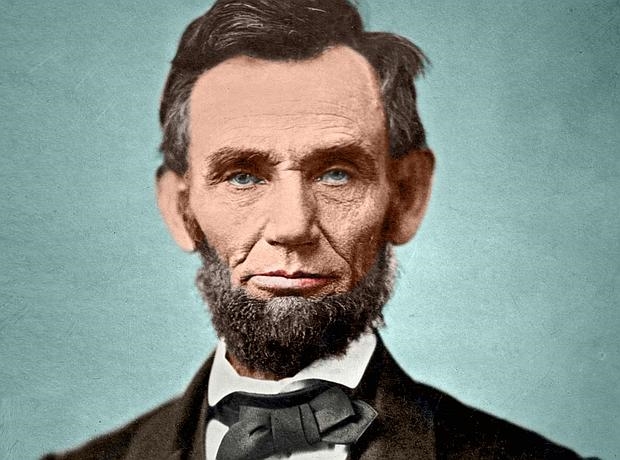Reading B2.1 ABRAHAM LINCOLN AMERICAN IDOL

After his assassination in April 1865, President Abraham Lincoln “became immortal in the American imagination”, as one biographer famously put in. Born in a simple log cabin 200 years ago this year, Lincoln grew up to become the man who freed America’s slaves while guiding the country through a terrible Civil War. One of America’s most beloved icons. Lincoln’s name and fame played a fundamental role in the election campaign which made Barack Obama America’s first-ever President.
Lincoln was born on February 12, 1809, in a one-room log cabin near Hodgenville, Kentucky, the son of poor pioneers. Brought up on farms in Kentucky, Indiana and finally Illinois, Lincoln largely educated himself. After qualifying as a lawyer, he entered the Illinois state legislature and finally reached Congress in 1846. Just 14 years later, although still completely unknown to most Americans but increasingly recognized within Washington for his great debating ability and brilliant oratory. Lincoln was chosen by the Republican Party, over a number of bitter rivals, as its Presidential candidate.
1. ____________________________
The 1860 Presidential campaign was dominated by the fight for the abolition of slavery, an issue which divided the Northern and Southern American states. Lincoln was strongly opposed to slavery.
The country seemed to be moving towards civil war and, by the time Lincoln had been elected President, 11 states had left the Union to form the Confederate States of America under a different flag. Lincoln considered secession illegal and pledged to preserve the Union.
Lincoln then showed his political genius. In an act which stunned Washington, he puts his bitterest Republican rivals, such as William Seward, along with a number of highly talented Democrats, in his first cabinet Lincoln’s renowned ‘team of rivals’. Lincoln bypassed traditional concepts of political allegiance and simply said that they were the best people for the job.
When civil war broke out in April 1861, Lincoln called it a struggle to save the Union. In January 1863, however, he issued the Emancipation Proclamation, an important symbolic gesture which freed all slaves in Confederate areas and turned the Civil War into a fight against slavery. The step came just after he had told black leaders that the presence of their race had caused the war and that they should all leave the country.
Ten months later, in a speech in Gettysburg, Pennsylvania, remembering those who had died for the Union, he made one of the most famous speeches in American history, which included the historic phrase “… and that government of the people, by the people, for the people, shall not perish from the earth.”.
After winning re-election in 1864, in the middle of the Civil War, Lincoln was conciliatory towards the South, talking in his celebrated inaugural address of showing “malice toward none; with charity for all”, words later inscribed on the Lincoln Memorial in Washington. Staying true to his fundamental beliefs, however, Lincoln then introduced the Thirteenth Amendment, abolishing slavery.
2. ____________________________
By April 1865, the North had won the war and 600000 Americans were dead. Lincoln, in victory, was flexible and generous, inviting Southerners to re-join the Union quickly. His plans for the future were cut off forever, however, when a Confederate supporter shot him in Ford’s Theatre in Washington on April 14, 1865.
Lincoln’s assassination, the first of an American President, shocked the world and led to an enormous public outpouring of grief. American politicians, however, quickly forgot the humanitarian wishes of the ‘Great Emancipator’, concentrating instead on reconciliation with the South. Racial segregation was introduced and for decades black people suffered terrible discrimination in all areas of life.
After segregation in schools was declared unconstitutional in 1952, the position of blacks slowly started to improve, but it took another 56 years of fighting for their rights before America’s black population finally saw a black man elected to the highest position in the land.
For most Americans, Abraham Lincoln is a cultural icon. Instantly recognizable, then and now, for his stovepipe hat, lanky stature and bushy beard, he guided the country through the Civil War and abolished slavery. He also, very importantly, epitomizes the ‘American Dream’ of the ‘self-made man’, rising from extremely modest beginnings to become President of the country. Lincoln led America for just five years, but his actions and brave decisions would change the direction of the country forever.
3. ____________________________
Since his very first days as a Presidential candidate, Barack Obama has cited Abraham Lincoln numerous times as the example that Americans have to follow, both in terms of reuniting a very politically-divided country and in confronting one of the worst economic crises in US history. Lincoln, Obama has said, is “one of my heroes”. In fact, there are many similarities between the two men. Both made their careers as lawyers in Illinois, before entering the Illinois state legislature, to finally make their way to the Presidency. On his victory night, echoing Lincoln’s desire to reunite a people on the edge of civil war, Obama quoted from Lincoln’s first inaugural address: “We are not enemies, but friends… though passion may have strained, it must not break our bonds of affection.”. Obama took the oath of office using Lincoln’s bible, the first president to do so. He then tried to create, like Lincoln, a ‘team of rivals’ administration, inviting former Democratic opponents Hillary Clinton and Joe Biden, and a number of Republicans, into his cabinet in order to “get this country through this time of crisis.“
4. ____________________________
In 1876, a gang of Chicago counterfeiters devised an extraordinary plan, to steal Lincoln’s dead body from Oak Ridge Cemetery in Springfield, Illinois, and hold it for ransom. They wanted $200,000 from the authorities and the release from prison of the gang’s master engraver. The Secret Service quickly infiltrated the gang members entered Lincoln’s burial chamber, which was protected by just one padlock, and broke open the white marble sarcophagus. They found It impossible, however, to lift the 500-pound coffin. At that moment, the Secret Service men outside mistakenly started shooting at each other.
The robbers escaped but were later captured. In 1901, Lincoln’s coffin was put inside a steel cage, lowered into a 10-foot-deep vault, and covered with tons of wet concrete.
Abraham Lincoln Reading B2.1
Comprehension questions
Vocabulary in Abraham Lincoln Reading exercise.
